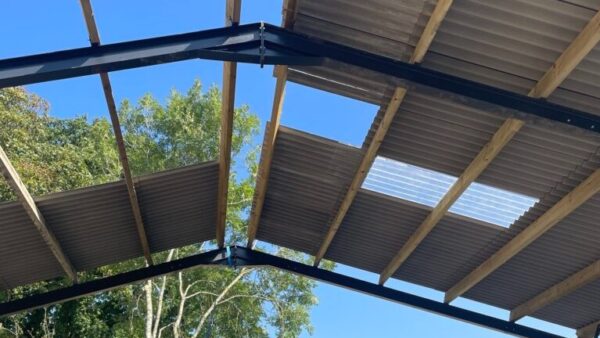
Willmott Dixon and Scape’s pre-designed schools joint venture Sunesis has recruited a new operations head from a local authority. Fran Cox tells Will Mann why she believes offsite manufacturing is the future for the education sector.
She liked the product so much that she joined the company.
Fran Cox was working in Bedfordshire Council’s education department when she brought in Sunesis, the pre-designed schools joint venture between Willmott Dixon and Scape, to deliver a new academy and primary school in just two years using its off-the-shelf concept.
The experience worked out so well for all parties that she was recruited to head up Sunesis in the newly created role of operations director last August.
“Local authority budgets are tight, and Bedfordshire is no exception, and we had to deliver these two schools quickly, without much money, and with multiple stakeholders to keep happy,” Cox explains. “As a client, the beauty of Sunesis was the simplicity of what they offered: clear timescales for delivery, flexibility where necessary, and certainty of cost.”
Previously Bedfordshire’s head of school organisation and infrastructure, and a psychologist by profession, Cox feels there are significant advantages in education embracing offsite manufacturing – her key message in her new role.
Sunesis takes a “kit of parts” approach, as Cox puts it, using offsite manufacturing widely but mixing it with in-situ building methods.
“Our starting position at Sunesis is to use modular as much as possible,” she says. “Apart from the quality and programme advantages, it can also help where there are space constraints in the site; we’ve craned in modules from dual carriageways and from churchyards.
Fran Cox CV
- Current role: Operations director, Sunesis
- 2006-17 Bedfordshire County Council
- 2014-17 Head of school organisation and infrastructure
- 2010-14 Education project manager
- 2008-10 Education commissioning manager
- 2006-08 Psychologist
- 2003-06 University of Reading, honours degree in psychology
“We have a new scheme just come in where the classrooms will be modular, but the gateway building will be CLT. I can see a popular hybrid emerging where many elements of the school, including the classrooms, are volumetric, but the gateway or atrium – the ‘wow’ factor of the school – are built using a different methodology.”
Cox stresses that Sunesis will always pick the methodology that is right for the project. “Sometimes volumetric will not work,” she notes. “In those cases, we will still use other offsite methods where we can: floor cassettes, wall systems. Generally, we want to reduce wet trades as much as possible.”
Sunesis currently offers three pre-designed primary school concepts, the Keynes, Paxton and Dewey, which can be tweaked according to form entry size and customer requirements. Projects are designed by Lungfish Architects, a Scape subsidiary which is “well versed in the cost implications of changing a design”, says Cox. “They design from a budget rather than a concept.”
Projects are currently designed in BIM Level 1, though Cox says Sunesis is moving up to Level 2 at the moment.
“Modular suppliers generally design in BIM, notably Eco Modular, who are front runners in education,” she says. “We also want to use 4D BIM for programming, particularly for crane movements on modular projects.”
Willmott Dixon has first refusal on all contracts, but as some schemes are quite small – for example, a one-class block for £250,000 – other Scape framework contractors such as Kier or Wates may be offered the work.
“Or we could go straight to a Tier 2 contractor like Eco Modular, depending on the project,” says Cox. “However, nine times out of 10, I think the main contractor expertise will be necessary for the groundworks and other in-situ elements.”
For Riseley Primary School in Bedford, a one-form entry school, the £2m project was delivered on site in 12 weeks. “This was a live school site, and about 70% of the project was completed in the factory by Eco Modular Buildings – constructing and fitting out of the classrooms – with the groundworks and cladding delivered on site,” says Cox.
In contrast, two other schools on adjoining sites, the £5m Wixams Primary School and £13.7m Wixams Academy, were delivered largely in situ, using steel frame construction. For the latter project, Sunesis had to adapt its designs to meet Education and Skills Funding Agency (ESFA) requirements.
“While there are certain boundaries that cannot move, they have plenty of scope to make it feel like ‘their school’.”
Fran Cox, Sunesis
“The Academy was a free school with stringent design requirements, for example the corridors had to be 1.8m wide, whereas in our standardised Keynes model, they are 3m wide,” explains Cox. “The architect was able to redesign the off-the-shelf model in 48 hours, which reduced the footprint, but still left plenty of large open spaces in the interior. This also took £300,000 off the cost. It demonstrates the flexibility of the Sunesis approach.”
Cox believes the speed and certainty of the model will appeal. “The design team can take the trust through the school design, and while there are certain boundaries that cannot move, they have plenty of scope to make it feel like ‘their school’, through colour schemes and finishes,” she says.
“Wixams Academy was very science led, and that was reflected in the fit-out, which included Mac suites. When we move up to BIM Level 2 it will allow clients to walk through the project virtually.”
She acknowledges there is an education process to go through. “There are connotations about prefabrication, and at Bedfordshire we had to do a lot of work with stakeholders who thought we would be supplying temporary buildings, which education professionals have had quite enough of,” she says.
Related articles
- Has offsite’s time finally arrived?
- CITB to launch offsite training courses
- Skanska’s ‘flying factories’ take off in Slough
“There is also an issue about local supply chain spend, as most modular suppliers are currently from north-east England. But from a quality perspective, I don’t think clients will have any issue at all with the finished product that Sunesis supplies.” It plans to revisit projects two years after completion, to carry out a post-occupancy evaluation.
Since its first commission in 2011, Sunesis has completed 28 primary schools, plus 40 extensions, creating more than 18,000 school places and aims to deliver more than 7,500 by 2020. Its other local authority clients include Somerset, Isle of Wight, Warwickshire, Lincolnshire, Plymouth, Doncaster, Croydon and North Somerset.
It is targeting rising demand in the sector, with the Department for Education forecasting last year that an extra 750,000 school places would be needed by 2025. The ambition is to lift turnover at Sunesis from the current £25m to £100m in three years’ time.
Although from a non-construction background, Cox is not fazed. “I don’t pretend I’m something I’m not, but I do understand what customers in this market need,” she says. “My job is about communication, building relationships, finding a common outcome and working together to get there. Being a psychologist helps with understanding people.”
Comments
Comments are closed.











I remember Scola, Clasp and many others. Most have been pulled down because they were a disaster.
Strangely enough the Victorians used a modular system called a brick and those buildings are still standing.
I also remember the Fram High rise buildings. We said at the time you wont keep the water out, the architects gave us the “we know what we are doing” look.
The buildings never kept the water out and now have been pulled down.
Designers keep trying to re-invent the wheel. They never learn.
Real shame.